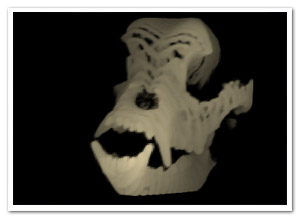Hi Ole,
I'm not sure I understand what you're after.
The example you supplied draws 2d paths, but merely uses z. scaling would have worked
in a similar way.
So How to dinamicly construct 3d
object by adding path's ?
Do you mean extruding/lathing an object, or replicating the scrunch sketch ?
Drawing a path is easy in processing, you just place vertex objects, in a for loop
between beginShape() and endShape() calls.
Here is the bit of code that does that in the example you've sent:
beginShape();
for (int p=0; p<pcount; p++){
vertex(Ring[p].position().x(),Ring[p].position().y());
}
endShape(CLOSE);
you can also call vertex(x,y,z)
I wanted to extrude a path a while back, here is my question in case it helps.
Basic sketch is uploaded here.
EDIT:
If you have an array of 2 polygons, you can just loop through them, and draw
using something similar to beginShape() and endShape(), GL_POLYGON might be handy.
e.g.
import processing.opengl.*;
import javax.media.opengl.*;
int zSpacing = 10;
PVector[][] slices;
void setup() {
size(600, 500, OPENGL);
slices = new PVector[3][3];
//dummy slice 1
slices[0][0] = new PVector(400, 200,-200);
slices[0][1] = new PVector(300, 400,-200);
slices[0][2] = new PVector(500, 400,-200);
//dummy slice 2
slices[1][0] = new PVector(410, 210,-200);
slices[1][1] = new PVector(310, 410,-200);
slices[1][2] = new PVector(510, 410,-200);
//dummy slice 3
slices[2][0] = new PVector(420, 220,-200);
slices[2][1] = new PVector(320, 420,-200);
slices[2][2] = new PVector(520, 420,-200);
}
void draw() {
background(255);
PGraphicsOpenGL pgl = (PGraphicsOpenGL) g; // g may change
GL gl = pgl.beginGL(); // always use the GL object returned by beginGL
for(int i = 0 ; i < slices.length; i ++){
gl.glColor3f(0, .15 * i, 0);
gl.glBegin(GL.GL_POLYGON);
for(int j = 0; j < slices[i].length; j++){
gl.glVertex3f(slices[i][j].x, slices[i][j].y,slices[i][j].z + (zSpacing * i));
}
gl.glEnd();
}
pgl.endGL();
}
The idea is you loop through each slice, and for each slice your loop through all its points. Obviously slices and the number of 3d vectors inside each slice is up to your data. Speaking of which, where does your data come from ?
If slices is not what your after volTron could come in handy:

HTH,
George


